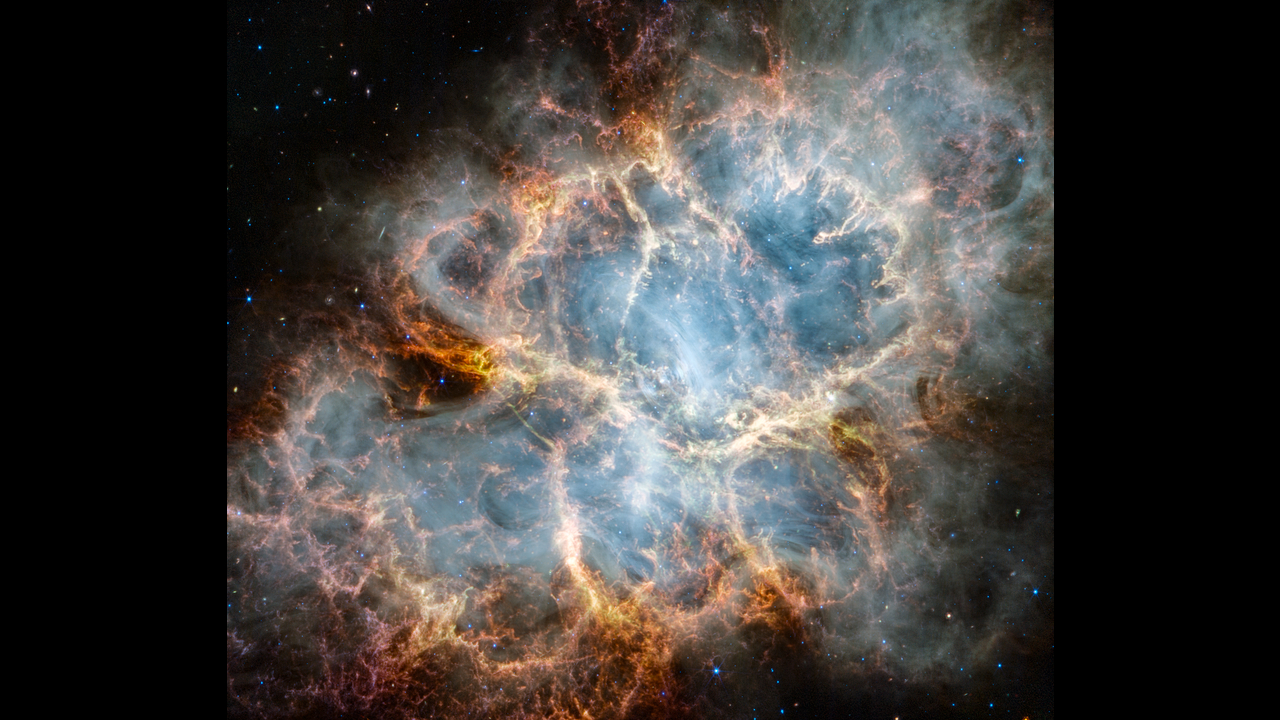James Webb Space Telescope dives deep into the Crab Nebula supernova wreckage (video)
The powerful space telescope has gazed into the Crab Nebula, looking for clues about its creation and offering us an ethereal view.
Using the James Webb Space Telescope (JWST), a team of astronomers has captured an unprecedented, ethereal view of the Crab Nebula.
This cosmic crustacean, located around 6,500 light-years away in the constellation of Taurus, is the remnant of a supernova first recorded by 11th-century astronomers in 1054. In the modern era of astronomy, the Crab Nebula continues to enthrall scientists who use this relatively close cloud of gas and dust to study how stellar explosions proceed and what their after-effects are.
"The JWST’s sensitivity and spatial resolution allow us to accurately determine the composition of the ejected material, particularly the content of iron and nickel, which may reveal what type of explosion produced the Crab Nebula," team leader and Princeton University researcher Tea Temim said in a statement.
The JWST observed the nebula in infrared using its NIRCam (Near-Infrared Camera) and MIRI (Mid-Infrared Instrument) instruments, seeing the general infrared shape of the nebula closely resembling the shape seen in optical light. However, there the observatory did reveal some stunning new details.
Related: James Webb Space Telescope spots jet stream on Jupiter stronger than a Category 5 hurricane
The anatomy of a cosmic crab
In the data collected by the JWST, red-orange, fluffy tendrils of gas can be seen caging the central heart of the Crab Nebula. What is new in these observations are dust grain emissions seen at the nebula's core glowing in yellow, white and green. Loops of these brightly-colored filaments represent concentrated locations of dust grains in the structure.
The JWST's view of the Crab Nebula also shows new details about the inner workings of this material that was once blasted from a supernova. In particular, the powerful space telescope uncovered emissions from a type of radiation in the nebula called synchrotron radiation. Appearing as milky white smoke in the image, this radiation is produced by charged particles called electrons moving along magnetic field lines at speeds approaching that of light, known as "relativistic" speeds.
Breaking space news, the latest updates on rocket launches, skywatching events and more!
This radiation stems from a rapidly rotating neutron star, or pulsar, at the heart of the supernova wreckage. When the massive star collapsed at the end of its life, it would've triggered the supernova that caused the wreckage itself. The pulsar's powerful magnetic field of the pulsar would've accelerated the charged particles to relativistic speeds.
The heart of the Crab Nebula can be traced in the image by following circular ripples in the middle of the image to the bright white dot that sits at the center. Leading out from this are closely clustered curving wisps that show the structure of the magnetic fields of the pulsars as they determine the Crab Nebula’s shape.
The neutron star’s location is marked by white material curving sharply inwards from the edges of the red, dusty and spine-like cage that surrounds it. This abrupt “pinching” of the Crab Nebula could be the result of a belt of dense gas constraining the expansion of supernova winds, even as winds from the central pulsar push a shell of gas and dust rapidly outward.
Scientists will continue to examine JWST data collected from the Crab Nebula as they await data collected from its fellow space telescope, Hubble, which has recently completed its first look at the nebula for over two decades.
When this Hubble data lands, astronomers can then put together observations from both space telescopes to learn more about the Crab Nebula than ever before.

Robert Lea is a science journalist in the U.K. whose articles have been published in Physics World, New Scientist, Astronomy Magazine, All About Space, Newsweek and ZME Science. He also writes about science communication for Elsevier and the European Journal of Physics. Rob holds a bachelor of science degree in physics and astronomy from the U.K.’s Open University. Follow him on Twitter @sciencef1rst.

